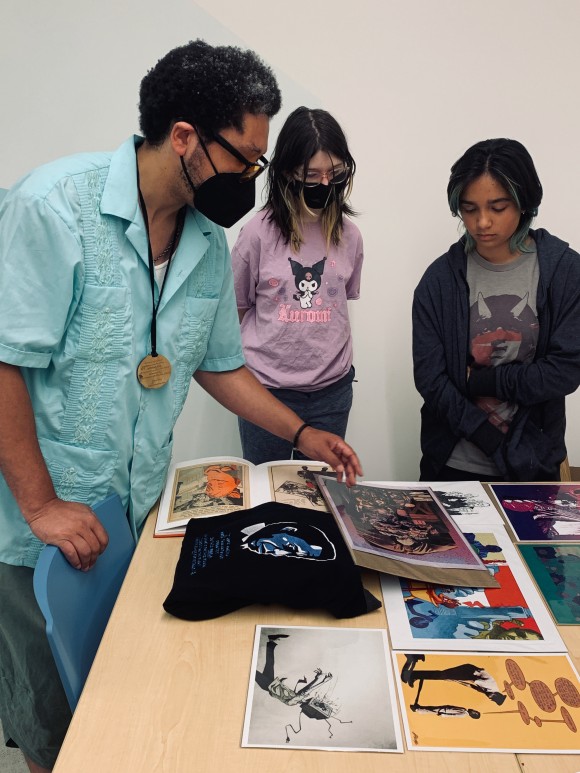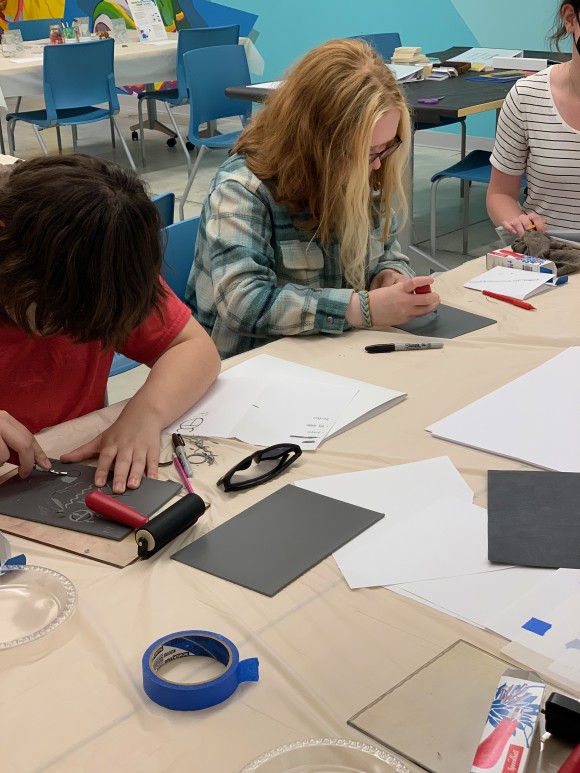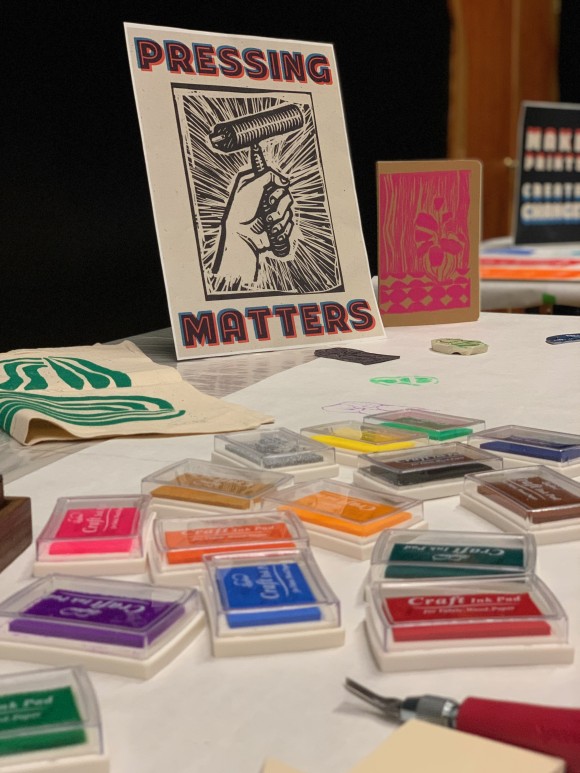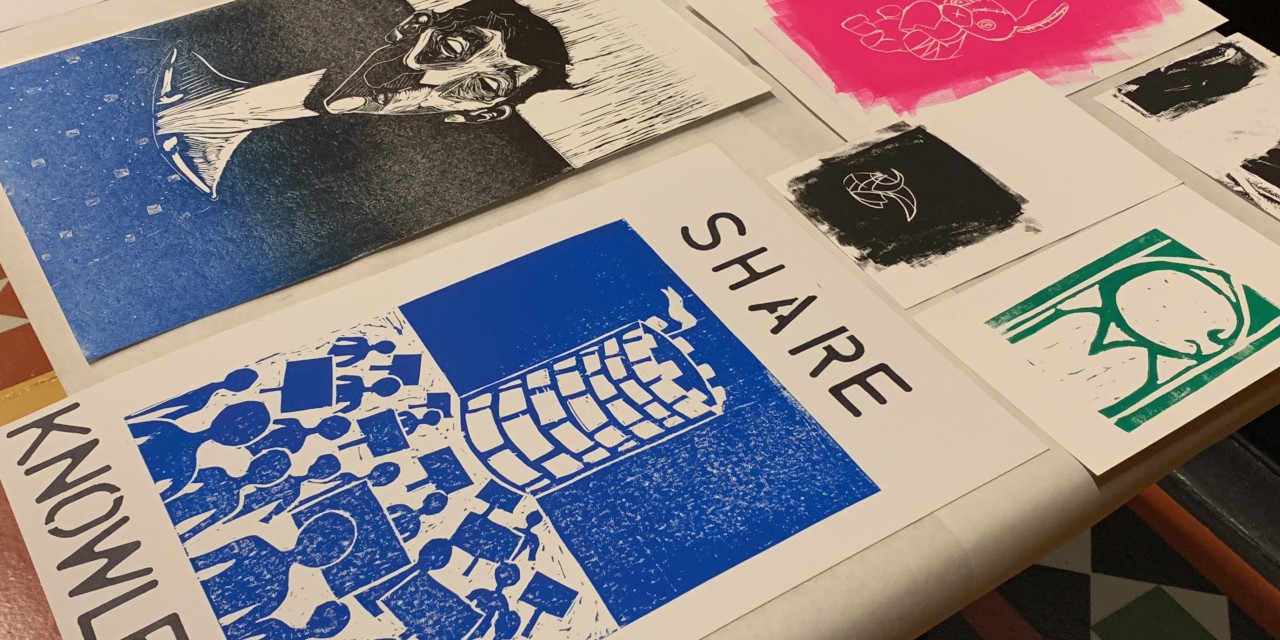Pressing Matters is a public humanities project that facilitates participatory printmaking, visual literacy, and self advocacy for a range of participants in Cleveland, Ohio. Consisting primarily of two components, an art history course at Case Western Reserve University (CWRU) and a teen printmaking workshop held in the predominantly Latinx Clark-Fulton neighborhood on Cleveland’s west side, the project is collaboratively run by CWRU Art History professor, Erin Benay, and staff members of Zygote Press, a nonprofit printmaking studio and education facility in Cleveland.
Pressing Matters is organized thematically around printmaking as a medium of collective social activism and includes hands-on instruction in printmaking together with academic instruction in art historical analysis. With support from a Social and Racial Justice Grant from the Expanding Horizons Initiative at CWRU, the first Pressing Matters art history course at CWRU took place in Spring 2022, and the first summer workshop for teens took place over seven weeks from June to July, 2022.
After years of academic research about printmaking and years of her own printmaking practice, Benay conceived of Pressing Matters as a way to bring artistic practice and humanistic inquiry together.
Benay developed the project in collaboration with Zygote Press’ Executive Director Jackie Feldman and Senior Program Manager Brittany Hudak and designed the CWRU course to introduce students to the history of printmaking and provide them with hands-on experience in both printmaking and public humanities programming. Open to advanced undergraduates and graduate students and cross-listed in art history and the public humanities, the Spring 2022 Pressing Matters course led students through exercises that helped them to develop the curriculum for the Summer 2022 Pressing Matters printmaking and social action workshop for teens that took place at Cleveland Museum of Art’s Community Art Center in the Clark-Fulton neighborhood.
Benay, Feldman, and Hudak envisioned Pressing Matters as an introduction to the political power and democratic potential that printmaking holds for those of varying ages, experiences, and demographics in the context of Cleveland’s social and cultural arts landscape. They thought carefully about how to engage both the college students at CWRU and high school students with ideas of social change through participatory art. One important aspect of this was to put Cleveland’s own history with printmaking, especially as it intersected with race and political action, in conversation with more recent printmaking trends in Cleveland. In the 1930’s and 1940’s a number of Black printmakers involved with Cleveland’s Karamu House — a Black performing and community arts center — rose to national prominence for their vivid depictions of local issues, both positive and negative, affecting their communities. Yet after the 1940’s, this history of printmaking in Cleveland was obscured by the mostly white Euroamerican printmakers and collectors who came to dominate printmaking in Cleveland. The longer history of Kamaru house printmaking helped to ground Pressing Matters in the politics of its locale.
In comparison to most art history classes, which do not typically incorporate studio time, one third of the CWRU Pressing Matters class meetings took place at Zygote Press where undergraduate and graduate students gained hands-on experience using the printmaking presses and learned first-hand what it means to work in an arts non-profit environment. In addition to the academic components of the class, this hands-on training at Zygote had a great impact on how the CWRU students thought about what to include in the summer workshop curriculum for teens. “When they got into the studio and got ‘inky’ as we say, they said ‘wow, this is very different from what we imagined! This is much more time consuming. This is much more challenging. How are we going to talk about the history of print and its connection to social justice and self-advocacy in a way that will be engaging and relevant to teens from under-resourced communities?"



In developing the curriculum and related materials for the teens, Benay, the Zygote team, and the college students also recognized and tried to work against the negative consequences that can come from arts based campaigns in urban neighborhoods. Revitalization in the form of arts programs can often lead to residential displacement and gentrification, and Benay, the Zygote team, and the college students who developed the summer workshop curriculum for teens, carefully considered how to launch the workshop at the Community Arts Center in a way that would most benefit long time residents of the Clark Fulton neighborhood, a predominantly Puerto Rican neighborhood. Feldman says that the students had a number of thoughtful discussions with Zygote staff members on what it means to work with communities. “Students were interested in how to actually engage with a community, not as a white savior, creating a program to hand it to the community and saying, ‘This is what you need, here you are, you're welcome,’” Feldman recalls. “They wanted to understand how to intentionally take the time to meet a community first, to invite a community to take ownership of a project, and let the project evolve from there.”
In the summer of 2022, Benay and the Zygote team implemented the CWRU students’ curriculum in the workshop for teens at the Community Arts Center. Like the CWRU course, this seven-week workshop combined the history of printmaking in America with hands-on printmaking skillbuilding to encourage participants to think about how printmaking can be used for social change. However, rather than teaching the historical significance of printmaking through lectures — as Benay had done in the CWRU course — the instructors of the workshop taught this history by weaving important historical events into their hands-on training in printmaking. Participants met once every week for a three hour session during which they simultaneously learned how to operate the presses, how printmaking has been used for social change throughout the twentieth century, and how to explore ways it can continue to serve as an effective tool for social change.
To further demonstrate to students the relationship between printmaking and social activism, and to root this connection in the contemporary moment, the workshop also included visiting guest artists who spoke about how they use art in their own practice to effect social change. One visiting artist, Zygote resident artist Amanda King, brought her experience as a photographer and director of Shooting without Bullets — a Cleveland based non-profit that provides teens with cameras — to the workshop. From this perspective, King talked with students about the role of art in spurring connections and how personal identity can intersect and inform community identity.
Throughout the teen workshop, students conceived of and created prints with images and words that depicted issues of importance to them. Print themes varied widely as students chose any topic that they found personally significant. Feldman explains that this is one area where teens may differ from college students in how they engage with printmaking. “We don't want to be politically heavy handed, because sometimes those are not the issues that students are concerned with, or they don't think of them as explicitly political," Feldman says. "So we don’t want to dictate what constitutes social justice art.” Teens in the program made prints that focused on a diverse range of issues, including “Protecting Our Pollinators!” and offering equal access to information and knowledge. As a culmination of the workshop, Zygote hosted a print sale of the posters created by the participants, with the proceeds donated to different non-profits of the participants’ choosing.


While Pressing Matters has completed the work funded by the Racial and Social Justice grant, Benay and Zygote are committed to expanding the Pressing Matters workshops to work with other neighborhoods in Cleveland. They imagine that future iterations will share a careful attention to place and the dynamics of neighborhoods and therefore vary depending on their location and the demographics of the participants. Nonetheless, they hope that the model of combining the history of printmaking with hands-on experience in printmaking will remain the same, as will the notion that printmaking can build academic, artistic, and advocacy skills.
As Feldman points out, printmaking is uniquely well suited for a public humanities project because it encourages both personal and political expression, and it can be more accessible than other art forms: “Printmaking allows artists to make their work accessible to a multitude of people by creating multiples of a single design and making them available at a lower cost,” Feldman states. Additionally, printmaking engenders sophisticated layering of material and textual forms by bringing literature, visual form, and advocacy together in different registers. “It allows artists to express themselves in ways that are unique in terms of being able to marry tactile, visual, and literary forms of expression," Feldman elaborates. "Printmaking allows artists to work in a cross-disciplinary spectrum, giving life to messages that speak literally in words, while also communicating in images and even textures.”
September, 2022.
